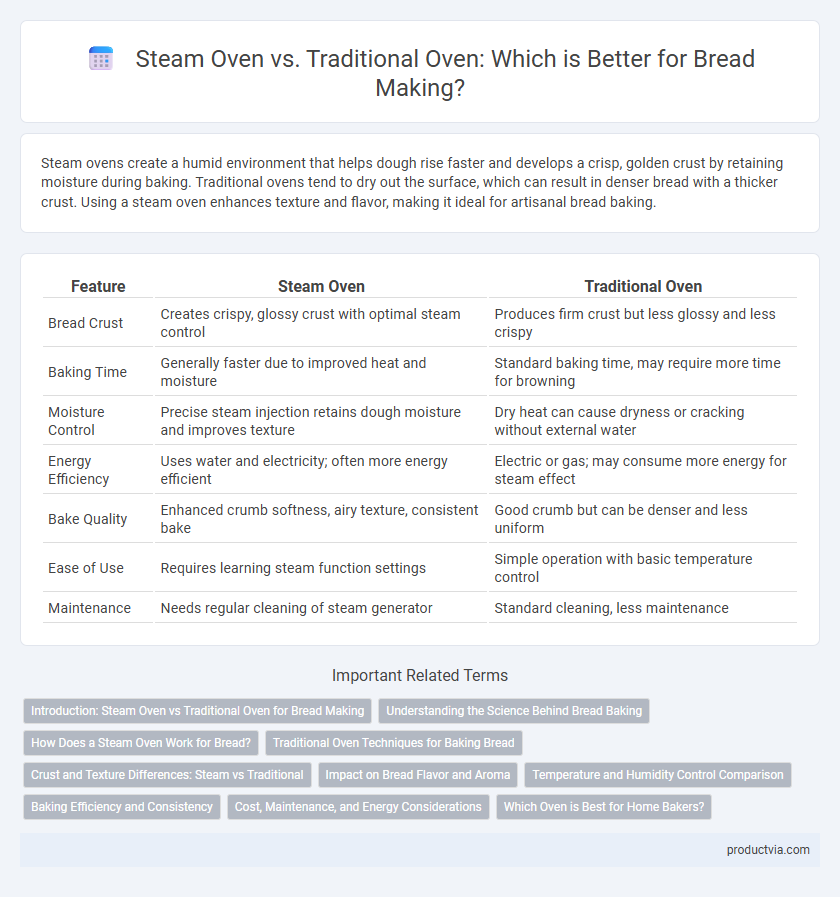Steam ovens create a humid environment that helps dough rise faster and develops a crisp, golden crust by retaining moisture during baking. Traditional ovens tend to dry out the surface, which can result in denser bread with a thicker crust. Using a steam oven enhances texture and flavor, making it ideal for artisanal bread baking.
Table of Comparison
| Feature | Steam Oven | Traditional Oven |
|---|---|---|
| Bread Crust | Creates crispy, glossy crust with optimal steam control | Produces firm crust but less glossy and less crispy |
| Baking Time | Generally faster due to improved heat and moisture | Standard baking time, may require more time for browning |
| Moisture Control | Precise steam injection retains dough moisture and improves texture | Dry heat can cause dryness or cracking without external water |
| Energy Efficiency | Uses water and electricity; often more energy efficient | Electric or gas; may consume more energy for steam effect |
| Bake Quality | Enhanced crumb softness, airy texture, consistent bake | Good crumb but can be denser and less uniform |
| Ease of Use | Requires learning steam function settings | Simple operation with basic temperature control |
| Maintenance | Needs regular cleaning of steam generator | Standard cleaning, less maintenance |
Introduction: Steam Oven vs Traditional Oven for Bread Making
Steam ovens enhance bread making by injecting moisture during baking, resulting in a crispier crust and softer crumb compared to traditional ovens. Traditional ovens rely solely on dry heat, which can lead to drier, less evenly textured bread. The use of steam in baking improves oven spring and crust coloration, making steam ovens a preferred choice for artisanal bread.
Understanding the Science Behind Bread Baking
Steam ovens enhance bread baking by injecting moisture during the initial baking phase, which promotes better crust formation and improved oven spring due to gelatinization of starches. Traditional ovens rely solely on dry heat, often resulting in a thicker, harder crust but less oven spring as moisture evaporates quickly. Understanding the interaction between steam and heat reveals why steam ovens yield superior texture and volume in artisan bread baking.
How Does a Steam Oven Work for Bread?
A steam oven enhances bread making by injecting controlled steam during baking, which maintains moisture on the dough's surface, promoting better crust development and a glossy finish. The steam delays crust formation, allowing the bread to rise fully and achieve a lighter, airier crumb structure. This precise steam control distinguishes steam ovens from traditional ovens, which rely solely on dry heat and often result in denser bread with less crust crispness.
Traditional Oven Techniques for Baking Bread
Traditional oven techniques for baking bread rely on dry heat and consistent temperatures to create a crusty exterior and tender crumb. Techniques such as using baking stones or adding a pan of water to generate steam help mimic artisan bakery conditions, enhancing crust development and oven spring. Mastery of temperature control and baking time is essential to achieve evenly baked loaves with rich flavor and texture.
Crust and Texture Differences: Steam vs Traditional
Steam ovens create a crispier and more evenly browned crust on bread by injecting moisture during baking, which promotes better oven spring and gelatinization of starches. Traditional ovens often produce a drier, thicker crust that can be tougher and less uniform due to the lack of controlled humidity. The texture inside bread from a steam oven tends to be softer and more open, while traditional ovens yield a denser crumb with a firmer bite.
Impact on Bread Flavor and Aroma
Steam ovens enhance bread flavor and aroma by maintaining optimal humidity, which promotes better crust formation and a moist crumb, resulting in richer, more complex taste profiles. Traditional ovens often produce drier crusts, potentially leading to less pronounced flavor development due to moisture loss during baking. The steam injection in steam ovens also facilitates Maillard reactions, deepening the bread's aroma and creating a more appealing sensory experience.
Temperature and Humidity Control Comparison
Steam ovens offer precise humidity control alongside temperature regulation, which enhances bread crust texture and crumb moisture by preventing excessive drying during baking. Traditional ovens rely solely on temperature control, often requiring manual methods like adding water to create steam, resulting in less consistent humidity levels and variable crust quality. The combination of controlled steam and accurate temperature in steam ovens promotes superior oven spring and a more uniform bake compared to traditional ovens.
Baking Efficiency and Consistency
Steam ovens provide superior baking efficiency for bread making by maintaining optimal moisture levels, resulting in evenly risen loaves with a crisp crust. Traditional ovens often struggle to retain moisture, leading to inconsistent bread texture and longer baking times. Professional bakers prefer steam ovens for their ability to deliver consistent crumb structure and uniform browning across multiple batches.
Cost, Maintenance, and Energy Considerations
Steam ovens typically have higher upfront costs compared to traditional ovens, but they offer superior moisture control that enhances bread quality. Maintenance for steam ovens involves regular descaling and water reservoir cleaning, whereas traditional ovens require less frequent upkeep. Energy consumption in steam ovens may be higher due to water heating, but improved baking efficiency can offset this over time.
Which Oven is Best for Home Bakers?
Steam ovens provide superior moisture control and consistent heat distribution, resulting in bread with a crisp crust and tender crumb, ideal for home bakers seeking bakery-quality results. Traditional ovens, while versatile and widely accessible, often lack the precise humidity control needed for optimal bread rise and crust development. Home bakers prioritizing texture and crust quality benefit most from steam ovens, whereas traditional ovens remain a practical choice for general baking needs.
Steam oven vs Traditional oven for bread making Infographic

 productvia.com
productvia.com